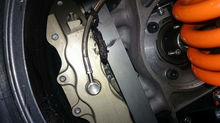Braking Systems
- Alex Harrington
- Nov 17, 2015
- 3 min read
The lesson this week was about braking systems for road cars and race cars. The system is made up of a few components; the brake pedal. The brake master cylinder/reservoir, the brake hard lines, and the callipers and disks.
Most modern road cars have brake servos, these are mounted on the bulkhead and use a vacuum created from the inlet on the engine and a diaphragm to assist the pushrod, making it easier for the driver to press on the pedal. Some every modern road car and some race cars also have ABS (Anti-lock braking system) this uses an ABS modulator that uses four solenoids for each of the hard lines for each calliper and when the wheel speed sensor detects that the wheel is locked the ECU uses the solenoids to quickly block the hard lines and this reduces the pressure in the line and releases the pressure on the calliper and allows the wheel to turn. We use ABS because when the wheel is locked up we get less efficient braking so it is there for safety. From a racing point of view we are concerned about safety but also this would reduce the risk of flat spotting a tyre which would allow the driver to brake later, harder and more confident but the regulations in most racing series don’t allow this system.
The basic braking system works by the driver pressing the pedal which pushes the pushrod down the master cylinder and in here the brake fluid is drawn from the reservoir and is pressurised in the lines. The fluid travels down the hard lines and is split off front to rear, this is for safety in case something fails then we will have at least one axle that can be braked and slow the car. The fluid then reaches the calliper itself, in the calliper we have pistons that extend when the fluid behind them is pressurised and this then pushes the brake pad into contact with the disk which creates friction and slows the rotation of the wheel.
Common issues with braking systems are wear, fade and pad knock off. Basic wear cannot be helped as over time more of the carbon or steel will wear off the disk and fade is when the disk is getting too hot and the disk can begin to warp, if the disk warps then the pedal will feel bumpy as the disk is wobbling between the pads. Pad knock off is if a car has gone over a curb a bit too aggressively and moves the pads wider than they usually sit, this can lead to the driver making a mistake on the brakes as there will be more pedal travel than they were expecting, once the brakes have been used the pads will usually go back to the same place until the driver makes another mistake.


The nearest master cylinder is for the hydauliclly operated clutch and the two farthest away in the picture are for the braking system, one for the front two callipers and one for the rear callipers.
To calculate the line pressure in the braking system we can take the force into the master cylinder (accounting for the brake pedal ratio) and divide this by the master cylinder bore area to find the pressure.
P=F/A
The pedal ratio is the distance from the pivot to the centre of the foot pad divided by the distance from the pushrod connection to the pivot point.















Comments